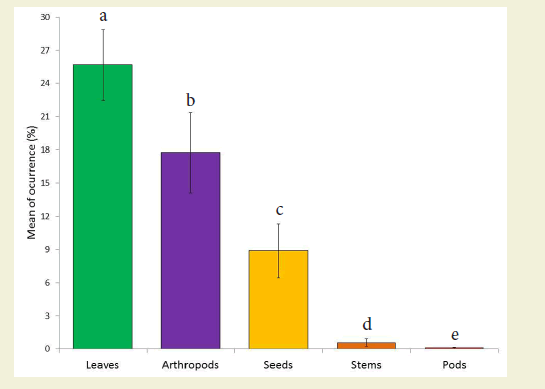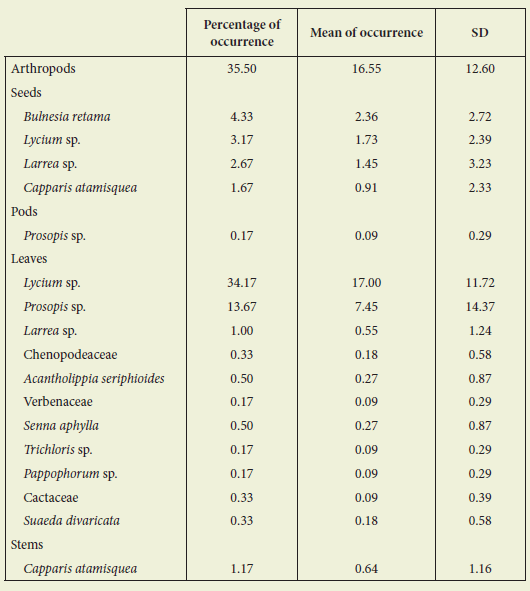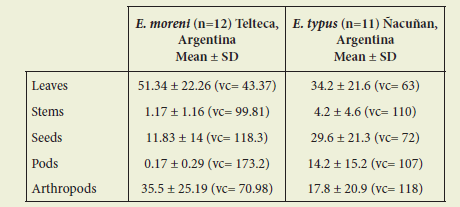Serviços Personalizados
Journal
Artigo
Indicadores
-
 Citado por SciELO
Citado por SciELO
Links relacionados
-
 Similares em
SciELO
Similares em
SciELO  uBio
uBio
Compartilhar
Multequina
versão On-line ISSN 1852-7329
Multequina vol.21 no.1 Mendoza jan./jun. 2012
ARTÍCULO ORIGINAL
Dry season diet composition of Eligmodontia moreni (Rodentia, Cricetidae, Sigmodontinae) in a hyper-arid region of the Monte desert (Mendoza, Argentina)
Composición de la dieta de Eligmodontia moreni (Rodentia, Cricetidae, Sigmodontinae) durante la estación seca en una región hiperárida del desierto del Monte (Mendoza, Argentina)
Cecilia Lanzone1, 2, Verónica Chillo1, Daniela Rodríguez1, María Ana Dacar1 & Claudia M. Campos1, 3
1 Grupo de Investigaciones de la Biodiversidad, IADIZA, CCT-Mendoza, CONICET, CC 507, (5500) Mendoza, Argentina.
2 Laboratorio de Genética Evolutiva, IBS-UNaM-CONICET, FCEQyN, Félix de Azara 1552, CP3300 Posadas, Misiones, Argentina, CONICET.
3 INTERBIODES, CONICET- Universidad Nacional de San Juan, San Juan, Argentina. <celanzone@mendoza-conicet.gob.ar>, <vchillo@mendoza-conicet.gob.ar>, <mdrodrig@mendoza-conicet.gob.ar>, <mdacar@mendoza-conicet.gob.ar>, <ccampos@mendoza-conicet.gob.ar>
Summary
We report the diet of Eligmodontia moreni during a dry season in a hyper-arid region of the Monte desert. Most eaten items were plant leaves, arthropods and seeds. Besides the high consumption of leaves, it should be considered as omnivorous with tendency to herbivory due to the high variability in consumption. The high consumption of arthropods was not recorded for other species of the genus. E. moreni shows a high flexibility in the diet, and this may be advantageous in these unpredictable environments.
Key words: Desert rodent; Microhistological technique; Omnivory; Telteca Reserve
Resumen
Presentamos la dieta de Eligmodontia moreni durante la estación seca en una región hiperárida del desierto del Monte. Encontramos diferencias en el consumo de las diferentes categorías, resultando las hojas y los artrópodos los ítems más utilizados, seguidos por las semillas. A pesar del elevado consumo de hojas, la especie debe considerarse omnívora con tendencia a la herbivoría debido a la elevada variabilidad en su dieta. Los altos porcentajes de artrópodos en la dieta no han sido registrados para otras especies del género. E. moreni muestra una importante flexibilidad en la dieta lo cual puede resultar ventajoso en ambientes donde los recursos tróficos son escasos e impredecibles.
Palabras clave: Omnivoría; Reserva Telteca; Roedor de desierto; Ttécnica microhistológica
Introduction
Among the different resources used by a species, food is considered one of the most important because it provides the energy necessary for survival and reproduction (Manly et al., 2010). Particularly, in systems such as deserts where productivity is very low and precipitations are scarce and highly unpredictable, small mammals can adopt different dietary strategies for coping with challenges of survival and reproduction (Kerley, 1992). In North American deserts, granivory is the dominant dietary strategy among rodent species; while in Australian, South African and South American deserts the most common dietary strategies of small mammals are insectivory, omnivory and herbivory respectively (Mares & Rosenzweig, 1978; Kerley, 1992; Murray et al., 1999; Campos et al., 2001; Giannoni et al., 2005).
The genus Eligmodontia (Cuvier, 1837) is characteristic of the arid lands of South America and possesses several anatomical and physiological adaptations for xeric environments (Díaz & Ojeda, 1999). Nevertheless, of six recognized species of the genus, only the diets of E. typus (Cuvier, 1837) and E. hirtipes (Thomas, 1902) have been documented. Both species are considered omnivorous, being leaves the main consumed food item (Campos et al., 2001; Silva, 2005; Giannoni et al., 2005). These species are completely allopatric, occurring E. hirtipes in the Altiplano of Chile and E. typus in the Central Monte desert of Argentina (Lanzone, 2009).
In the Central Monte desert, another species of the genus also occurs: E. moreni (silky mouse), occupying the northern and more arid portion of the Monte biome (Lanzone et al., 2007). This species is sometimes found in sympathry with E. typus and three other phyllotine rodents in hyperarid regions, with mean annual precipitations values of 150 mm, and low resource availability (Rodríguez et al., 2012). Recent research shows that this species is a habitat generalist, with a wide habitat niche breadth and greatest abundances in open habitats such as sand dunes and saltbushes (Rodríguez et al., 2012). But basic information about the natural history of E. moreni, such as diet, is absent in literature. Therefore, our main objective is to describe the composition of the diet of E. moreni during the dry season in a hyper arid portion of the Monte desert, in order to assess the feeding strategy of the species when the productivity is low and resource availability is reduced.
Material and method
During a field expedition in May of 2004 to the locality of Telteca Reserve (Central Monte desert biome, Mendoza, Argentina) we captured 17 specimens of Eligmodontia with live Sherman traps. Animals collected during this study were treated following the procedures recommended by the American Society of Mammalogists (Sikes et al., 2011). All individuals were karyotyped in order to corroborate their taxonomic status (Lanzone et al., 2007). This analysis showed that 16 animals were E. moreni (2n = 52) and one was E. typus (2n = 44).
Feces of 12 E. moreni individuals were collected from depositions obtained in the traps or at the time of manipulation. Microscopic identification of plant species was performed by comparison with a reference collection, which consisted of microhistological slides of plant material. The reference material and the fecal samples were processed following the method described by Dacar & Giannoni (2001). Feces from each individual were macerated in a solution of NaHCO3 and one microscope slide was prepared. Fifty microscope fields were systematically examined on each slide under a microscope at 400×. Presence of food items was recorded for each field. Food items were grouped into the following categories: leaves, seeds, arthropods, stems, and pods. The percentage of occurrence of each item was determined by grouping the results of all individuals. Mean and standard deviation were calculated for all food items and categories without grouping individuals. A chisquare test was used to compare the absolute occurrences of the different food items in the diet of E. moreni. All analyses were performed using R 2.9.0 software.
Results and discussion
We found significant differences among food items consumed by E. moreni during the dry season (?2 = 611.03; df = 4; p<0.001), being leaves and arthropods the two most consumed items, followed by seeds (Figure 1).

Figure 1. Percentage of occurrence of items, grouped as categories, in the diet of Eligmodontia moreni in Telteca Reserve during the dry season. Different letters show significant differences between categories (Chi-square test)
Figura 1. Porcentaje de ocurrencia de los ítems, agrupados en categorías, en la dieta de Eligmodontia moreni en la Reserva Telteca durante la estación seca. Las diferentes letras indican diferencias significativas entre las categorías (prueba de Chi-cuadrado)
A total of 13 plant species were found in its diet, with leaves of Lycium sp. and Prosopis sp. being the most eaten plants (Table 1).
Table 1. Percentage of occurrence, mean and standard deviation (SD) of the specific items present in the diet of Eligmodontia moreni in Telteca Reserve during the dry season (Mendoza, Argentina)
Tabla 1. Porcentaje de ocurrencia, media y desvío estándar (SD) de los ítems específicos presentes en la dieta de Eligmodontia moreni en la Reserva Telteca durante la estación seca (Mendoza, Argentina)

According to Kerley and Whitford's (1994) classification, despite leaves consumption was slightly higher than 50% of the total, it should be considered as omnivorous with tendency to herbivory.
When comparing E. moreni's diet with the related species, E. typus, in a close region (Ñacuñán Reserve, approximately 300 km south), we found both species mainly feed on leaves. Nevertheless E. typus incorporates more seeds/pods, while E. moreni includes more arthropods (Table 2).
Table 2. Mean, standard deviation (SD) and variation coefficient (vc) of the main food categories in the dry season diet of Eligmodontia moreni (this publication) and E. typus (Giannoni et al., 2005)
Tabla 2. Media, desvío estándar (SD) y coeficiente de variación (vc) de las principales categorías que constituyen la dieta de Eligmodontia moreni (resultados de esta publicación) y de E. typus (Giannoni et al., 2005) en la estación seca

Also, high variation coefficients where registered for both species (Table 2). Moreover, the same plant species were the most frequently consumed items (22.17% of Lycium sp. and 4.17% of Prosopis sp. according to Giannoni et al., 2005).
Similar to other rodents of the Monte desert, and of other arid regions, E. moreni shows a varied diet during the dry season, with high standard deviation in the items consumed (Giannoni et al., 2005) and an omnivorous feeding strategy. This flexibility in food intake may be a good strategy in this hyper arid region of the Monte desert, where resources are scarse and unpredictable. The high consumption of arthropod by E. moreni, when comparing with E. typus could be related to the more xeric habitat of occurrence. In this sense, the presence of arthropods in its diet could act as a protein supplement in time of food shortage (such as the dry season) and be related to physiological mechanisms for keeping a positive water balance on this extreme hyper arid region of Monte desert (Díaz & Ojeda, 1999). This high record of arthropods was not recorded previously for other species of the genus. Further studies are needed including diet analysis in different seasons and of different areas of the hyper arid region of the North of Mendoza in order to understand the extent of omnivory and flexibility in the diet of E. moreni and other coexistent species.
Acknowledgements
Our thanks to Silvia Brengio and Pablo Moreno for cooperation in field work, and to Nelly Horak for assistance with the English version. We thank Dr. Ricardo Ojeda for the continuous support and encouragement to carry out research. To the anonymous reviewers for theirs comments. This study was partially funded by CONICET PIP 2884 and SECYT PICT-11768 grants.
References
1. CAMPOS, C.M., R.A. OJEDA, S. MONGE & M. DACAR, 2001. Utilization of food resources by small and medium-sized mammals in the Monte Desert biome, Argentina. Austral Ecology 26: 142-149. [ Links ]
2. DACAR, M.A. & S.M. GIANNONI, 2001. A simple method for preparing slides of seed. Technical note. Journal of Range Management 54: 191-193. [ Links ]
3. DÍAZ, G.B. & R.A. OJEDA, 1999. Kidney structure of Argentine desert rodents. Journal of Arid Environments 41: 453-461. [ Links ]
4. GIANNONI, S.M., C.E. BORGHI, M.A. DACAR & C.M. CAMPOS, 2005. Main food categories in diets of sigmodontine rodents in the Monte (Argentina). Mastozoología Neotropical 12: 181-187. [ Links ]
5. KERLEY, G.I.H., 1992. Trophic status of small mammals in the semi-arid Karoo. South African Journal of Zoology 226: 563-572. [ Links ]
6. KERLEY, G.I.H. & W.G. WHITFORD, 1994. Desert-dwelling small mammals as granivores: intercontinental variations. Austral Journal of Zoology 42: 543-555. [ Links ]
7. LANZONE, C., R.A. OJEDA & M.H. GALLARDO, 2007. Integrative taxonomy, systematics and distribution of the genus Eligmodontia (Rodentia, Cricetidae, Sigmodontinae) in the temperate Monte Desert of Argentina. Mammalian Biology 72: 299-312. [ Links ]
8. LANZONE, C., 2009. Sistemática y evolución del género Eligmodontia (Rodentia, Muridae, Sigmodontinae). Tesis de Doctorado, Universidad Nacional de Córdoba, Argentina. [ Links ]
9. MARES, M.A. & M.L. ROSENZWEIG, 1978. Granivory in North and South American deserts: rodents, birds, and ants. Ecology 59: 235-241. [ Links ]
10. MANLY, B.F.J., L.L. MCDONALD, D.L. THOMAS, T.L. MCDONALD & W.P. ERICKSON, 2010. Resource selection by animals. Statistical design and analysis for field studies. Kluwer Academic Publishers, The Netherlands. [ Links ]
11. MURRAY, B.R., C.R. DICKMAN, C.H. WATTS & S.R. MORTON, 1999. The dietary ecology of Australian desert rodents. Wildlife Research 26: 421-437. [ Links ]
12. RODRÍGUEZ, D., C. LANZONE, V. CHILLO, P. CUELLO, S. ALBANESE, A. OJEDA & R. OJEDA, 2012. Historia natural de un roedor raro del desierto argentino, Salinomys delicatus (Cricetidae, Sigmodontinae). Revista Chilena de Historia Natural 85: 13-27. [ Links ]
13. SIKES, R. S., W. L. GANNONI & THE ANIMAL CARE AND USE COMMITTEE OF THE AMERICAN SOCIETY OF MAMMALOGISTS, 2011. Guidelines of the American Society of Mammalogists for the use of wild mammals in research. Journal of Mammalogy 92(1):235-253. [ Links ]
14. SILVA, S.I., 2005. Posiciones tróficas de pequeños mamíferos en Chile: una revisión. Revista Chilena de Historia Natural 78: 589-599. [ Links ]
Recibido: 06/2012
Aceptado: 11/2012














